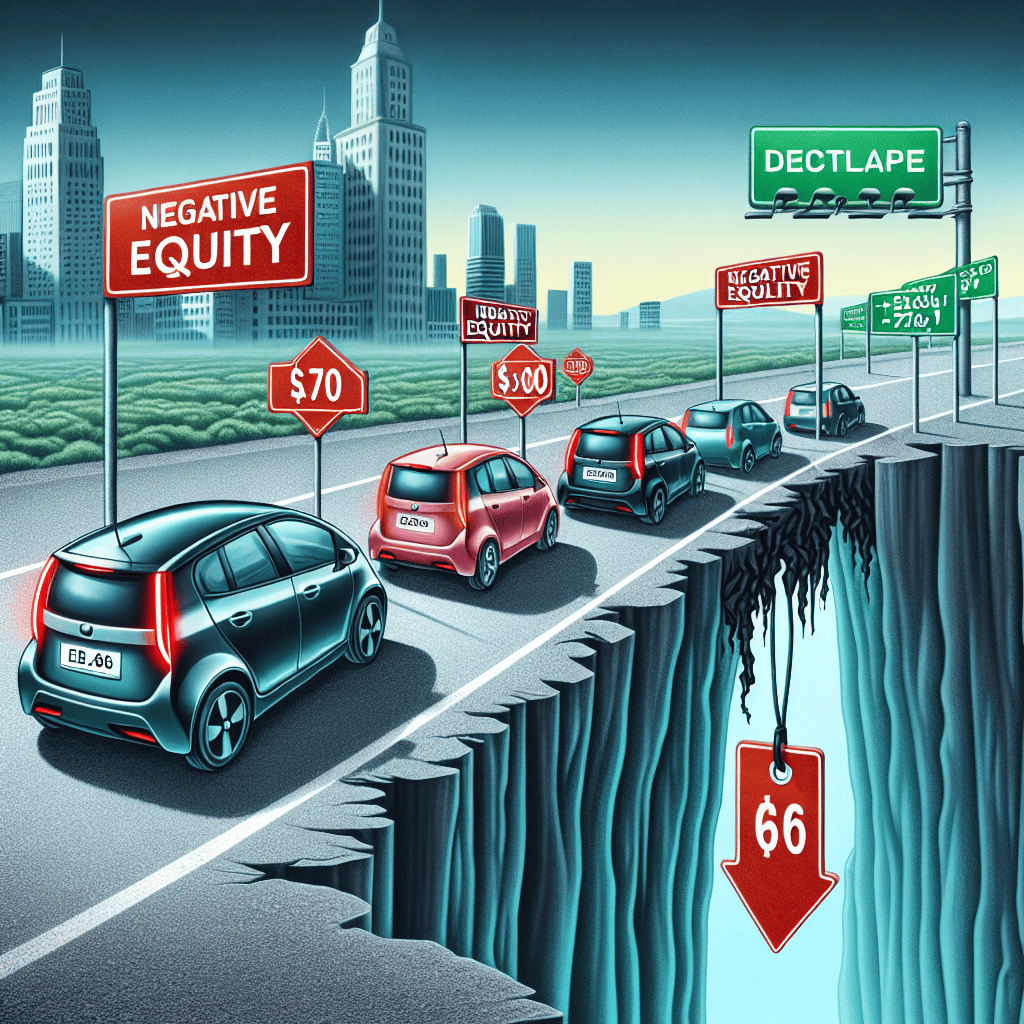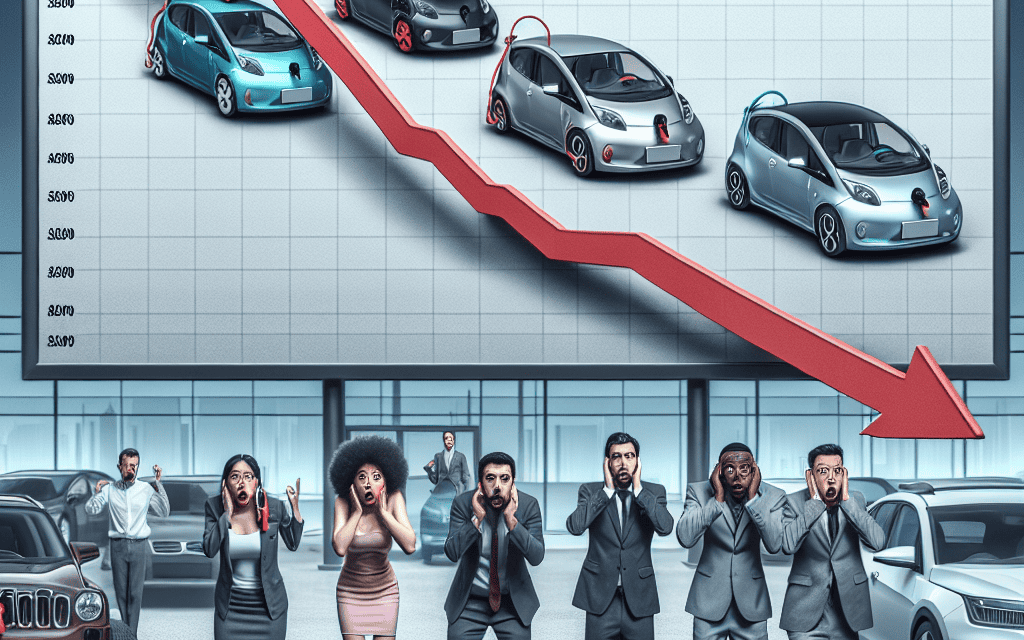“Shocking Downturn: Electric Car Owners Face Financial Freefall as Values Plummet”
Introduction
Electric car drivers are facing a challenging financial landscape as the market experiences a significant downturn, leading to a situation where many are being plunged into negative equity. This phenomenon occurs when the value of an asset, in this case, electric vehicles (EVs), falls below the outstanding balance on the loan used to purchase it. The rapid depreciation in EV prices can be attributed to several factors, including increased production, technological advancements, and shifts in consumer demand. As a result, owners who financed their electric cars are finding themselves in a precarious position, owing more on their loans than their vehicles are currently worth. This situation not only impacts individual finances but also raises broader concerns about the stability and sustainability of the burgeoning electric vehicle market.
Impact Of Plummeting Electric Car Prices On Driver Equity
The rapid evolution of the electric vehicle (EV) market has brought about significant changes, not only in the automotive industry but also in the financial landscape for consumers. As electric car prices continue to plummet, many drivers find themselves in a precarious financial situation, facing the daunting prospect of negative equity. This phenomenon occurs when the value of an asset, in this case, an electric vehicle, falls below the outstanding balance on the loan used to purchase it. Consequently, owners are left owing more on their car loans than the vehicles are worth, a situation that can have far-reaching implications.
The primary driver behind the decline in electric car prices is the accelerated pace of technological advancements. As manufacturers introduce newer models with enhanced features, longer ranges, and improved battery technologies, older models depreciate more rapidly. This depreciation is further exacerbated by the increasing number of automakers entering the EV market, intensifying competition and driving down prices. While these developments are beneficial for prospective buyers, offering them more affordable options, they pose a significant challenge for current owners who financed their purchases at higher price points.
Moreover, government incentives and subsidies aimed at promoting the adoption of electric vehicles have played a crucial role in shaping the market dynamics. These incentives, while encouraging the transition to cleaner energy, have inadvertently contributed to the depreciation of existing electric vehicles. As new buyers take advantage of these financial benefits, the resale value of older models diminishes, leaving current owners in a difficult position. This situation is particularly concerning for those who purchased their vehicles with the expectation of a stable or appreciating asset.
In addition to technological advancements and government policies, the global economic climate has also influenced the electric vehicle market. Fluctuations in raw material costs, supply chain disruptions, and changes in consumer demand have all contributed to the volatility in electric car prices. As a result, owners who financed their vehicles during periods of higher prices are now facing the harsh reality of negative equity. This financial strain can be particularly burdensome for individuals who rely on their vehicles for daily commuting or business purposes, as they may find themselves unable to sell or trade in their cars without incurring significant losses.
To mitigate the impact of negative equity, electric car owners can explore several strategies. Refinancing their auto loans to secure lower interest rates or extended terms may provide some relief by reducing monthly payments. Additionally, maintaining their vehicles in excellent condition and keeping up with regular maintenance can help preserve their value over time. For those considering purchasing an electric vehicle, it is essential to conduct thorough research and consider factors such as depreciation rates, resale values, and potential future market trends.
In conclusion, the collapse in electric car prices has created a challenging environment for current owners, many of whom are grappling with negative equity. While the rapid advancement of technology and increased competition have made electric vehicles more accessible to a broader audience, they have also led to significant depreciation of existing models. As the market continues to evolve, it is crucial for both current and prospective electric car owners to remain informed and proactive in managing their financial investments. By understanding the factors contributing to price fluctuations and exploring available options, drivers can better navigate the complexities of the electric vehicle market and safeguard their financial well-being.
Understanding Negative Equity In The Electric Vehicle Market
The electric vehicle (EV) market, once heralded as the vanguard of sustainable transportation, is currently facing an unexpected challenge: the phenomenon of negative equity. This situation arises when the value of an asset, in this case, electric cars, falls below the outstanding balance on the loan used to purchase it. As the prices of electric vehicles experience a significant decline, many drivers find themselves in the precarious position of owing more on their car loans than their vehicles are worth. Understanding the factors contributing to this predicament is crucial for both current and prospective EV owners.
To begin with, the rapid depreciation of electric vehicles can be attributed to several interrelated factors. One primary reason is the swift pace of technological advancements in the EV sector. As manufacturers continuously innovate, newer models with enhanced features, longer ranges, and improved battery technologies are introduced to the market. Consequently, older models depreciate faster as they become less desirable, leading to a drop in their resale value. This accelerated depreciation is more pronounced in the EV market compared to traditional internal combustion engine vehicles, where technological changes occur at a slower pace.
Moreover, government incentives and subsidies, which have been instrumental in promoting the adoption of electric vehicles, also play a role in this dynamic. While these incentives make new EVs more affordable, they inadvertently contribute to the depreciation of used models. As consumers are enticed by the financial benefits of purchasing new electric cars, the demand for used EVs diminishes, further driving down their prices. This situation is exacerbated by the fact that many incentives are not applicable to second-hand purchases, making new vehicles more attractive.
In addition to these factors, the increasing competition within the EV market has led to a surge in the supply of electric cars. As more manufacturers enter the market and expand their offerings, the abundance of choices available to consumers exerts downward pressure on prices. This competitive environment benefits buyers in terms of variety and affordability but poses challenges for current owners who see the value of their vehicles decline.
The implications of negative equity are significant for electric car owners. Those who financed their purchases through loans may find themselves unable to sell or trade in their vehicles without incurring a financial loss. This situation can be particularly burdensome for individuals who need to upgrade to a newer model or face unexpected financial difficulties. Furthermore, negative equity can affect the overall perception of electric vehicles, potentially deterring prospective buyers who fear similar financial pitfalls.
To mitigate the risks associated with negative equity, potential EV buyers should consider several strategies. Conducting thorough research on the depreciation rates of different models and opting for those with a history of retaining value can be beneficial. Additionally, making larger down payments or choosing shorter loan terms can help reduce the likelihood of negative equity. For current owners, staying informed about market trends and timing the sale or trade-in of their vehicles strategically can minimize financial losses.
In conclusion, while the electric vehicle market continues to evolve and expand, the issue of negative equity presents a challenge that cannot be overlooked. By understanding the factors contributing to this phenomenon and adopting prudent financial strategies, both current and prospective EV owners can navigate the complexities of this dynamic market more effectively. As the industry progresses, addressing these challenges will be essential to ensuring the long-term sustainability and appeal of electric vehicles.
Strategies For Electric Car Owners Facing Negative Equity
As the electric vehicle (EV) market continues to evolve, many electric car owners are finding themselves in a precarious financial situation due to the rapid depreciation of their vehicles. The phenomenon of negative equity, where the outstanding loan balance on a car exceeds its current market value, is becoming increasingly common among EV owners. This situation is primarily driven by the swift decline in electric car prices, influenced by technological advancements, increased competition, and government incentives aimed at promoting the adoption of newer, more efficient models. Consequently, electric car owners must adopt strategic approaches to mitigate the financial impact of negative equity.
To begin with, understanding the factors contributing to the depreciation of electric vehicles is crucial. The rapid pace of technological innovation in the EV sector means that newer models often come equipped with superior battery life, enhanced features, and improved performance. As a result, older models quickly lose their appeal, leading to a drop in resale value. Additionally, government incentives such as tax credits and rebates for purchasing new electric cars further exacerbate the depreciation of existing models. These incentives make new cars more financially attractive, thereby reducing the demand for used electric vehicles and driving down their prices.
Given these challenges, electric car owners facing negative equity should consider several strategies to manage their financial situation effectively. One potential approach is to refinance the existing car loan. By securing a lower interest rate or extending the loan term, owners can reduce their monthly payments, making it easier to manage the financial burden of negative equity. However, it is essential to weigh the long-term implications of refinancing, as extending the loan term may result in paying more interest over time.
Another viable strategy is to hold onto the vehicle for a longer period. While this may not be an ideal solution for everyone, especially those eager to upgrade to a newer model, it allows the owner to gradually pay down the loan balance. Over time, as the loan balance decreases and the car’s value stabilizes, the negative equity situation may resolve itself. This approach requires patience and a commitment to maintaining the vehicle in good condition to maximize its longevity and value.
For those who are determined to upgrade to a newer model, trading in the current vehicle may be an option, albeit with some financial considerations. While trading in a car with negative equity typically involves rolling the remaining loan balance into the new car loan, it is crucial to ensure that the new loan terms are manageable. This strategy requires careful negotiation with the dealership to minimize the financial impact and avoid exacerbating the negative equity situation.
Additionally, electric car owners can explore the possibility of selling their vehicle privately. Although this option may require more effort and time compared to trading in at a dealership, it often results in a higher sale price. By obtaining a better price, owners can reduce the gap between the car’s value and the outstanding loan balance, thereby alleviating some of the negative equity burden.
In conclusion, while the rapid depreciation of electric vehicles presents significant challenges for owners, there are several strategies available to navigate the complexities of negative equity. By understanding the factors driving depreciation and carefully considering options such as refinancing, holding onto the vehicle, trading in, or selling privately, electric car owners can make informed decisions to manage their financial situation effectively. As the electric vehicle market continues to mature, staying informed and proactive will be key to successfully navigating the evolving landscape.
The Role Of Depreciation In Electric Vehicle Value Decline

The rapid evolution of the automotive industry, particularly the surge in electric vehicle (EV) adoption, has brought about significant changes in the market dynamics. One of the most pressing issues currently facing electric car owners is the phenomenon of negative equity, a situation where the value of their vehicle falls below the outstanding balance on their car loan. This predicament is largely driven by the steep depreciation rates associated with electric vehicles, a factor that has become increasingly pronounced as the market becomes more saturated and competitive.
Depreciation, the gradual reduction in the value of an asset over time, is a natural occurrence in the automotive world. However, electric vehicles tend to depreciate at a faster rate compared to their internal combustion engine counterparts. Several factors contribute to this accelerated depreciation. Firstly, the rapid pace of technological advancements in the EV sector means that newer models often come equipped with superior features, longer ranges, and more efficient battery technologies. As a result, older models quickly become outdated, leading to a decline in their market value.
Moreover, government incentives and subsidies, which have been instrumental in promoting the adoption of electric vehicles, inadvertently contribute to depreciation. These incentives often apply to new purchases, making it more attractive for consumers to buy new rather than used EVs. Consequently, the demand for second-hand electric cars diminishes, further driving down their resale value. Additionally, the perception of battery degradation over time, despite improvements in battery technology and warranties, continues to affect consumer confidence in purchasing used electric vehicles.
The impact of depreciation is particularly concerning for those who have financed their electric vehicle purchases through loans. As the value of their car plummets, these owners find themselves in a situation where they owe more on their loan than the car is worth. This negative equity can be financially burdensome, especially if the owner wishes to sell or trade in their vehicle before the loan is paid off. The situation is exacerbated by the fact that many consumers are not fully aware of the potential for rapid depreciation when they initially purchase an electric vehicle.
To mitigate the risks associated with negative equity, potential EV buyers should consider several strategies. Conducting thorough research on the depreciation rates of different models can provide valuable insights into which vehicles hold their value better over time. Additionally, opting for shorter loan terms can help reduce the likelihood of negative equity, as the loan balance decreases more quickly. Leasing, rather than purchasing, is another viable option, as it allows consumers to avoid the long-term financial commitment and potential depreciation pitfalls associated with ownership.
In conclusion, while electric vehicles offer numerous environmental and economic benefits, the issue of depreciation and its role in creating negative equity is a significant concern for current and prospective owners. As the market continues to evolve, it is crucial for consumers to remain informed and consider the financial implications of their purchasing decisions. By understanding the factors that contribute to depreciation and taking proactive measures, electric car owners can better navigate the challenges of maintaining their vehicle’s value in a rapidly changing landscape.
How Market Trends Are Affecting Electric Car Resale Values
The electric vehicle (EV) market, once heralded as the vanguard of sustainable transportation, is currently experiencing a significant shift that is impacting the resale values of electric cars. As the market evolves, electric car owners are finding themselves in a precarious financial situation, with many being plunged into negative equity due to rapidly depreciating vehicle prices. This phenomenon is largely driven by a confluence of market trends that are reshaping the landscape of electric vehicle ownership.
To begin with, the rapid pace of technological advancement in the electric vehicle sector is a double-edged sword. On one hand, it has led to the development of more efficient, longer-range, and technologically advanced models. On the other hand, it has rendered older models less desirable, causing their resale values to plummet. As manufacturers continue to innovate, introducing new models with improved battery life and enhanced features, the depreciation rate of existing electric vehicles accelerates. Consequently, owners of older models find themselves with vehicles that are worth significantly less than the outstanding balance on their loans, thus entering negative equity.
Moreover, the increasing availability of government incentives for new electric vehicle purchases further exacerbates the depreciation of used electric cars. These incentives, designed to promote the adoption of electric vehicles, often make new models more financially attractive to consumers. As a result, the demand for used electric vehicles diminishes, leading to a surplus in the market and a subsequent drop in prices. This dynamic creates a challenging environment for current electric car owners who wish to sell or trade in their vehicles.
In addition to technological advancements and government incentives, the growing competition within the electric vehicle market also plays a crucial role in the declining resale values. With more automakers entering the EV space, the market is becoming increasingly saturated with a wide array of options for consumers. This heightened competition drives down prices as manufacturers strive to capture market share, further impacting the resale value of existing electric vehicles. As new entrants offer competitive pricing and innovative features, the perceived value of older models diminishes, leaving current owners at a disadvantage.
Furthermore, the evolving infrastructure for electric vehicles, while beneficial in the long term, presents short-term challenges for resale values. As charging networks expand and become more efficient, newer models are designed to take full advantage of these advancements. Older models, which may not be compatible with the latest charging technology, become less appealing to potential buyers, contributing to their depreciation.
In light of these factors, electric car owners are advised to carefully consider the financial implications of their purchase decisions. While the environmental benefits of electric vehicles are undeniable, the economic realities of ownership must also be taken into account. Prospective buyers should be aware of the rapid pace of technological change and the potential for significant depreciation, and they may want to explore leasing options or shorter loan terms to mitigate the risk of negative equity.
In conclusion, the electric vehicle market is undergoing a transformative period that is affecting the resale values of electric cars. As technological advancements, government incentives, increased competition, and evolving infrastructure continue to shape the market, electric car owners must navigate these changes with caution. By understanding the factors at play, they can make informed decisions that align with both their environmental values and financial goals.
Financial Implications Of Owning An Electric Car In A Volatile Market
The financial landscape for electric car owners is undergoing significant turbulence as the market experiences a sharp decline in vehicle prices, leading many drivers into the precarious situation of negative equity. This phenomenon occurs when the value of an asset falls below the outstanding balance on the loan used to purchase it. As electric vehicles (EVs) become more prevalent, the market dynamics are shifting rapidly, causing unforeseen financial implications for current owners.
One of the primary factors contributing to the depreciation of electric cars is the rapid advancement in technology. As manufacturers continue to innovate, newer models with enhanced features and improved battery life are introduced at a faster pace. Consequently, older models quickly lose their appeal and market value. This accelerated depreciation is more pronounced in the electric vehicle sector compared to traditional internal combustion engine vehicles, where technological advancements occur at a relatively slower rate. As a result, electric car owners find themselves in a challenging position, as the resale value of their vehicles plummets, leaving them with loans that exceed the current market value of their cars.
Moreover, the increasing competition among manufacturers has led to a significant reduction in the prices of new electric vehicles. As more companies enter the market, they strive to capture consumer attention by offering competitive pricing and attractive incentives. While this is beneficial for prospective buyers, it adversely affects current owners who see the value of their vehicles diminish. The introduction of government subsidies and tax incentives for new electric car purchases further exacerbates this issue, as it lowers the effective cost of new vehicles, thereby impacting the resale market.
In addition to technological advancements and market competition, external economic factors also play a crucial role in the depreciation of electric vehicles. Fluctuations in global oil prices, changes in government policies regarding environmental regulations, and shifts in consumer preferences towards sustainable transportation options all contribute to the volatility of the electric car market. These factors create an unpredictable environment, making it difficult for owners to accurately assess the long-term value of their investments.
To mitigate the risk of negative equity, electric car owners must adopt a proactive approach. One potential strategy is to consider leasing instead of purchasing. Leasing offers the advantage of lower monthly payments and eliminates the concern of depreciation, as the vehicle is returned to the leasing company at the end of the term. Additionally, owners can explore refinancing options to adjust their loan terms in response to changing market conditions. Staying informed about market trends and technological advancements can also help owners make more informed decisions regarding the timing of their vehicle purchases or sales.
In conclusion, the volatile nature of the electric car market presents significant financial challenges for current owners, as they navigate the complexities of negative equity. The rapid pace of technological advancements, increased market competition, and external economic factors all contribute to the depreciation of electric vehicles. By adopting strategic approaches such as leasing, refinancing, and staying informed, electric car owners can better manage the financial implications of owning an electric vehicle in this ever-evolving market. As the industry continues to grow and mature, it is essential for both consumers and manufacturers to remain vigilant and adaptable to the changing landscape.
Navigating The Challenges Of Negative Equity In Electric Cars
The rapid evolution of the electric vehicle (EV) market has brought about significant changes in the automotive industry, promising a cleaner and more sustainable future. However, as with any burgeoning market, there are challenges that consumers must navigate. One such challenge is the issue of negative equity, which is becoming increasingly prevalent among electric car owners as prices for these vehicles experience a sharp decline. Understanding the dynamics of this situation is crucial for both current and prospective EV owners.
Negative equity occurs when the value of an asset falls below the outstanding balance on the loan used to purchase it. In the context of electric cars, this means that the resale value of the vehicle is less than the amount still owed on its financing. This predicament can be attributed to several factors, including the rapid depreciation of EVs, the swift pace of technological advancements, and fluctuating market conditions. As newer models with improved features and longer ranges are introduced, older models tend to lose value more quickly, leaving owners with vehicles that are worth less than they owe.
Moreover, government incentives and subsidies, which have been instrumental in promoting the adoption of electric vehicles, can also contribute to this issue. These incentives often reduce the initial purchase price, but they do not necessarily stabilize the vehicle’s long-term value. As a result, when these incentives are phased out or reduced, the market can experience a sudden drop in demand, further exacerbating the depreciation of existing models.
In addition to these factors, the increasing competition in the EV market plays a significant role in driving down prices. As more manufacturers enter the market, the supply of electric vehicles grows, leading to more competitive pricing strategies. While this is beneficial for consumers looking to purchase new EVs, it can be detrimental to those who already own one, as it accelerates the depreciation of their vehicles.
To mitigate the risks associated with negative equity, electric car owners can take several proactive steps. Firstly, it is essential to conduct thorough research before purchasing an EV, considering factors such as the vehicle’s expected depreciation rate, the manufacturer’s reputation, and the potential for future technological advancements. Additionally, opting for shorter loan terms can help reduce the risk of negative equity, as it allows owners to pay off their loans more quickly and align their outstanding balance more closely with the vehicle’s depreciating value.
Leasing is another viable option for those concerned about negative equity. Leasing agreements typically involve lower monthly payments and allow consumers to drive a new vehicle every few years without the burden of ownership. This can be particularly advantageous in a rapidly evolving market, as it provides flexibility and reduces the financial impact of depreciation.
Furthermore, staying informed about market trends and developments in the EV industry can help owners make more strategic decisions regarding their vehicles. By understanding the factors that influence depreciation and resale values, consumers can better anticipate changes in the market and adjust their plans accordingly.
In conclusion, while the issue of negative equity presents a significant challenge for electric car owners, it is not insurmountable. By taking a proactive approach and staying informed, consumers can navigate the complexities of the EV market and make decisions that align with their financial goals. As the industry continues to evolve, it is crucial for both manufacturers and consumers to remain adaptable and responsive to the changing landscape.
Q&A
1. **What is negative equity in the context of electric cars?**
Negative equity occurs when the value of an electric car falls below the outstanding balance on the loan used to purchase it.
2. **Why are electric car prices collapsing?**
Prices are collapsing due to increased supply, reduced demand, and advancements in technology leading to newer models being more desirable.
3. **How does negative equity affect electric car drivers?**
Drivers may owe more on their car loans than the car is worth, making it difficult to sell or trade in the vehicle without incurring a financial loss.
4. **What factors contribute to the depreciation of electric cars?**
Factors include rapid technological advancements, government policy changes, and fluctuations in market demand.
5. **Are there specific models more affected by negative equity?**
Older models or those with outdated technology are more susceptible to rapid depreciation and negative equity.
6. **What can electric car owners do to avoid negative equity?**
Owners can make larger down payments, choose shorter loan terms, or regularly monitor market trends to time their purchases and sales better.
7. **How is the market responding to the issue of negative equity in electric cars?**
The market may see adjustments in pricing strategies, increased incentives for buyers, and more flexible financing options to address the issue.
Conclusion
The rapid depreciation of electric vehicle (EV) prices has led to a situation where many electric car owners find themselves in negative equity, meaning they owe more on their car loans than the vehicles are currently worth. This scenario is primarily driven by several factors, including the accelerated pace of technological advancements, which quickly render older models less desirable, and the increasing supply of used EVs in the market, which drives down prices. Additionally, government incentives and subsidies for new EV purchases can further depress the resale value of used models. As a result, electric car owners may face financial challenges, particularly if they need to sell or trade in their vehicles before the loans are paid off. This situation underscores the importance of considering potential depreciation and market trends when purchasing an electric vehicle.





